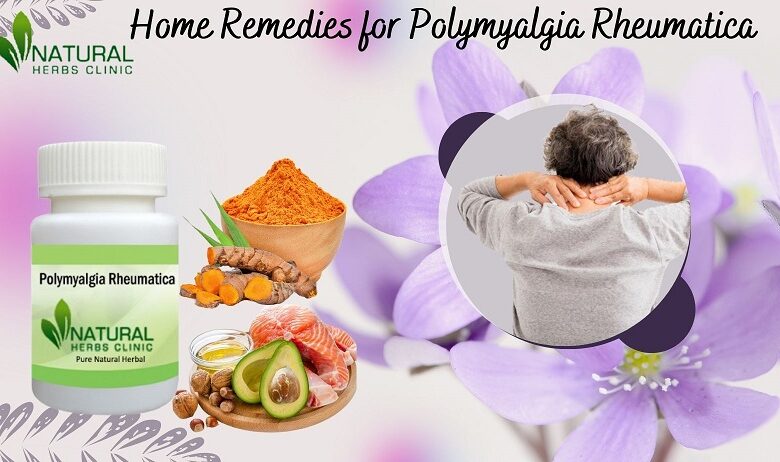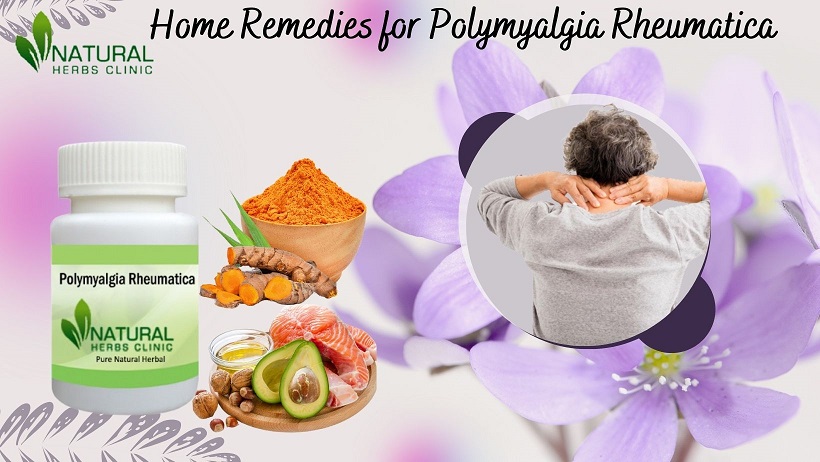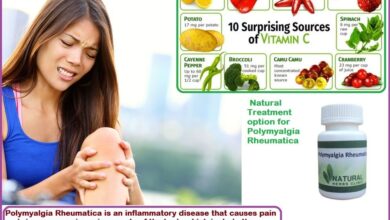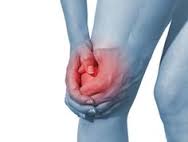Polymyalgia Rheumatica Why Home Treatments are Important to Treat it

Polymyalgia rheumatica can be treat with home remedies. Use of Home Remedies for Polymyalgia Rheumatica can lessen the symptoms and help in recovery.
What is Polymyalgia Rheumatica?
Polymyalgia rheumatica is a chronic pain and stiffness condition that affects the shoulders, neck, lower back, and hips. It can also cause discomfort and stiffness in the hands and wrists in certain people. The stiffness and pain are worst first thing in the morning or after long periods of rest, such as long vehicle rides or a couch nap. The stiffness can be so severe that it prevents persons with polymyalgia rheumatica from bending over to put on their shoes or pulling on a shirt by elevating their hands over their heads. Home Remedies for Polymyalgia Rheumatica can assist in providing relief from the disease.
Joint inflammation is common, yet there is no known aetiology for the disease. A doctor’s physical exam and blood tests to look for inflammation are used to diagnose it. A screening for erythrocyte sedimentation rate (the “sed” rate, or ESR) and C-reactive protein is frequently included in these assays (CRP). People with polymyalgia rheumatica frequently have high sed rates and CRP levels, although a rheumatologist may be able to identify the disorder even if they don’t have very high sed rates or CRP levels.
Polymyalgia rheumatica generally appears out of nowhere, sometimes as rapidly as overnight, but more often over several days or weeks. People with giant cell arteritis, commonly known as GCA or temporal arteritis, are more likely to develop the illness. Swelling (inflammation) of big blood vessels, notably in the head, neck, and shoulders, is a symptom of this illness.
Difference between fibromyalgia and polymyalgia rheumatica?
Because both disorders can produce muscle pain, stiffness, and exhaustion, some patients confuse the symptoms of polymyalgia rheumatica with those of fibromyalgia. Fibromyalgia pain, on the other hand, is usually more intense and affects more muscles and joints than polymyalgia rheumatica. Memory, sleep, toileting, and other elements of life can be affected in ways that polymyalgia rheumatica normally does not. Furthermore, inflammation is not a factor in fibromyalgia. A healthcare practitioner should make the diagnosis because the two diseases have different treatment options. (1)
Signs and Symptoms of Polymyalgia Rheumatica
Polymyalgia rheumatica has a constant set of indications and symptoms, which include:
Pain and stiffness in the shoulders, upper arms, neck, back, buttocks, thighs, or hips that is worst in the morning or after resting but improves with activity or as the day progresses
Pain and stiffness afflict both sides of the body, rather than just one shoulder or hip.
In some situations, difficulty moving the arms or affected areas through their full range of motion due to pain or stiffness in the elbows and wrists.
Some people may also suffer symptoms that are more broad, such as:
A little fever is present.
Fatigue
Loss of appetite or weight loss
A widespread sensation of malaise
Depression
People with giant cell arteritis or temporal arteritis may also experience other symptoms such as headaches, visual abnormalities, throbbing or warm scalp, and jaw stiffness. Temporal arteritis has the potential to cause major consequences and should be treated as soon as possible.
Causes and Risk Factors for Polymyalgia Rheumatica
The causes of polymyalgia rheumatica are unknown. Some believe it is caused by an infection, such as a virus, because it can appear suddenly and is more common at particular seasons of the year. No virus, however, has been discovered. It’s also possible that it’s an autoimmune illness, according to others. In most situations, muscle tissue samples (biopsies) taken from persons with polymyalgia rheumatica appear normal and healthy. Muscle discomfort and stiffness appear to be caused by inflammation in adjacent joints.
The following are some of the risk factors for polymyalgia rheumatica: (2)
Older age – The disease most commonly affects persons aged 70 to 80, however it can also afflict people aged 50 and more.
Genetics – People who carry specific genes are more prone to get the disease.
Polymyalgia rheumatica affects twice as many women as it does males.
Caucasians with Scandinavian or northern European ancestry are the most likely to get the disease.
Home Remedies for Polymyalgia Rheumatica Natural Treatments
Polymyalgia rheumatica has no proven natural remedies or quick diet fixes. There are, however, strategies to maximize your health by managing your food and activity. Furthermore, you can take actions to naturally control side effects from medical therapy or symptoms from connected health problems.
Make an anti-inflammatory diet a priority
The present understanding of polymyalgia rheumatica is closely tied to inflammation. Radiating pain and stiffness in surrounding muscles appear to be caused by joint inflammation. Although it has not been established that an anti-inflammatory diet can help with polymyalgia rheumatica or its symptoms, many healthcare providers recommend it as a simple method to offer your body more tools to combat inflammation. You can also realize that some meals help or hurt your symptoms. This can assist you in tailoring your personal “polymyalgia rheumatica diet” to your specific requirements. Please keep in mind that your diet may need to change if you have other medical issues, such as diabetes or heart disease. Consider the following anti-inflammatory dietary recommendations for polymyalgia rheumatica: (3), (4), (5)
Consume fats that are good for you. Omega-3 fatty acids can be found in walnuts, flax, salmon, and other fatty fish, as well as fish oil supplements, coconut oil, eggs, and other foods. This can be one of the helpful Home Remedies for Polymyalgia Rheumatica that work without any side effects.
Consume a diverse range of fruits and vegetables. Many disease-fighting diets include this as a fundamental component. A variety of fruits and vegetables provide a wide range of nutrients, as well as fiber, antioxidants, and other beneficial compounds. Prepare them healthily by eating them raw, baking, steaming, adding them to salads, or dressing them with only healthy dips or dressings. Cooking them in a lot of oil or drowning them in fatty or sweet sauces is not a good idea. Leafy greens, bok choy, celery, beets, broccoli, blueberries, and pineapple are some of the best anti-inflammatory fruits and vegetables. These Natural Remedies for Polymyalgia Rheumatica have value to treat the condition easily.
Choose whole grains whenever possible. Oats, brown rice, corn, quinoa, and other whole grains may help to reduce CRP, an inflammatory marker in the blood. Increased inflammation has been linked to refined carbohydrates and sweets.
Keep yourself hydrated. Hydration can aid in the fight against inflammation. Drink two to three liters of water every day as a minimum. Teas that are decaffeinated or herbal are also excellent sources of hydration.
Inflammatory foods should be avoided. Many processed meats, dishes with added sugar or white flour, pastries, margarine, fried foods, and red meat are all examples of this. Any foods to which you have a sensitivity, as well as any that tend to aggravate your symptoms, should be avoided.
Calcium and vitamin D should be consumed in large amounts
Not only does the risk of osteoporosis rise with age, but medical treatment for polymyalgia rheumatica (steroid therapy) can also weaken the bones. Get enough calcium and vitamin D in your diet or through supplements to prevent bone loss.
Calcium-rich foods include canned, bone-in salmon (such as sardines)
Milk, yoghurt, and other dairy products
Greens with lots of leaves
Almonds
Consume vitamin D-rich foods such as:
Eggs
Fish oil or fatty fish
Milk or drink with added vitamins
Liver of beef
Cereals with added nutrients
Mushrooms
Note: Vitamin D can also be obtained from the sun.
Adults 51 and over should strive for: (6) 1000–1200 mg of calcium per day through a combination of food and supplementation (Some adults may need more depending on their steroid use or other risk factors.)
Vitamin D levels should be between 600 and 800 IUs per day (Again, some adults may require more.)
Before beginning or changing your supplement regimen, speak with your polymyalgia rheumatica doctor.
Physical treatment or exercise
Exercise not only relieves the pain and stiffness associated with polymyalgia rheumatica in the morning, but it also helps to combat the health hazards associated with drugs. Weight gain, bone loss, poor blood sugar regulation, and other issues are among them. Here are a few suggestions to ensure that your physical activity is beneficial rather than harmful: (8)
Begin slowly and gently. If you are not physically active, speak with a healthcare expert about your choices. Weight-bearing exercise, such as walking or climbing stairs, can help prevent bone loss in most cases. For many patients with polymyalgia rheumatica, getting their bodies moving, even with low-impact activities, is preferable to rest.
Make a morning routine that works for you. Stretching, yoga, or another set of morning activities may assist relieve morning stiffness and soreness. Begin slowly and softly, gradually increasing your range of motion or the length of time you can hold poses. However, take it slowly. Exercising too much can exacerbate problems.
Make an appointment with a physical therapist. A few sessions with a physical therapist can provide you with a specific series of exercises to help you relieve pain, enhance range of motion, reduce inflammation, and relieve stiffness. The therapist should take into account your current physical abilities, the primary locations and types of pain and stiffness you experience in the morning, the limits your symptoms cause, and your goals for therapy. If you do the exercises every day, you should see a difference in your morning symptoms rather quickly.
Inquire about natural therapies and supplements
The study on specific Herbal supplements for Polymyalgia Rheumatica isn’t conclusive. However, the following are some possibly beneficial solutions for inflammation reduction, natural steroid synthesis, and pain relief: (9)
Traditional Chinese medicine — Patients in a research who received modified Yanghe Decoction in addition to medical steroid treatment saw an increase in remission rate and a drop in disease activity and ESR. They were also able to reduce their steroid dose more quickly than the control group (who took steroids alone). (10) Pantethine, as well as vitamins A, B6, and C, aid in the production of natural steroids in the body and enhance adrenal gland health. When the body’s steroid synthesis is working properly, you may be able to reduce inflammation naturally. Inquire about a pantethine dose of 600 milligrams per day, a vitamin A dose of 12,500–25,000 IUs per day, a B6 dose of 50–100 mg per day (as part of a B-complex vitamin), and a vitamin C dose of 1–2 grammes per day.
Omega-6 essential fatty acid (gamma linoleic acid or GLA) – Like omega-3, omega-6 is an anti-inflammatory natural oil that may help persons with polymyalgia rheumatica lessen morning stiffness. Primrose oil capsules and borage oil capsules include it. Aim for 3,000 mg of omega-3 fatty acids and 1,500 mg of omega-6 fatty acids each day.
Bromelain enteric-coated — This enzyme is derived from pineapple and has proven to be highly beneficial for many people with rheumatoid arthritis, which includes symptoms and inflammation that are very similar to polymyalgia rheumatica. Bromelain supplements helped people lower their steroid medicines and inflammation in clinical research. On an empty stomach, ask for 600 milligrams each day.
MSM (Methyl-sulphonyl-methane) is a sulphur chemical found in nature. It’s produced by your body to aid in the fight against artery discomfort and inflammation. To aid with joint pain and inflammation, ask about a short-term daily dose of approximately 1,000 milligrams.
Turmeric – Curcumin, often known as turmeric, has been shown to help with inflammation, pain, and depression. Many studies have found it to be particularly beneficial in treating symptoms of polymyalgia rheumatica-related disorders, such as rheumatoid arthritis. Consult a doctor to determine the optimal daily dosage for you. Include Turmeric in Home Remedies for Polymyalgia Rheumatica to obtain good result.




